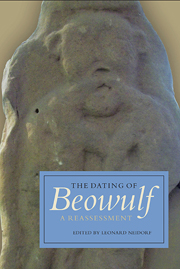Book contents
- Frontmatter
- Contents
- List of Tables
- List of Illustrations
- List of Contributors
- Acknowledgements
- Introduction
- 1 Beowulf and Language History
- 2 Germanic Legend, Scribal Errors, and Cultural Change
- 3 Names in Beowulf and Anglo-Saxon England
- 4 The Limits of Conservative Composition in Old English Poetry
- 5 The Date of Composition of Beowulf and the Evidence of Metrical Evolution
- 6 Beowulf and the Containment of Scyld in the West Saxon Royal Genealogy
- 7 History and Fiction in the Frisian Raid
- 8 ‘Give the People What They Want’: Historiography and Rhetorical History of the Dating of Beowulf Controversy
- 9 A Note on the Other Heorot
- 10 Beowulf and Conversion History
- 11 Material Monsters and Semantic Shifts
- 12 Scandals in Toronto: Kaluza's Law and Transliteration Errors
- 13 Afterword: Beowulf and Everything Else
- Index
7 - History and Fiction in the Frisian Raid
Published online by Cambridge University Press: 05 October 2014
- Frontmatter
- Contents
- List of Tables
- List of Illustrations
- List of Contributors
- Acknowledgements
- Introduction
- 1 Beowulf and Language History
- 2 Germanic Legend, Scribal Errors, and Cultural Change
- 3 Names in Beowulf and Anglo-Saxon England
- 4 The Limits of Conservative Composition in Old English Poetry
- 5 The Date of Composition of Beowulf and the Evidence of Metrical Evolution
- 6 Beowulf and the Containment of Scyld in the West Saxon Royal Genealogy
- 7 History and Fiction in the Frisian Raid
- 8 ‘Give the People What They Want’: Historiography and Rhetorical History of the Dating of Beowulf Controversy
- 9 A Note on the Other Heorot
- 10 Beowulf and Conversion History
- 11 Material Monsters and Semantic Shifts
- 12 Scandals in Toronto: Kaluza's Law and Transliteration Errors
- 13 Afterword: Beowulf and Everything Else
- Index
Summary
Beowulf is a remarkable poem to have been written at any time. Around 3,200 lines of linguistically and metrically sophisticated poetry that sets “two moments in a great life,” in J.R.R. Tolkien's phrase, into a distant past and conveys a profound respect for the hero's actions while at the same time expressing a sense of the loss and futility of that world, is a remarkable achievement. A poem not of an age, but for all time. Which is not to say that it is undatable or that its date does not matter. Even without external evidence such as manuscripts and editions, we would recognize that well-known accounts of the deeds of three northern European heroes from around the year 500 – Beowulf, Arthur, and Hamlet – were written by their authors – our poet, Malory, and Shakespeare – at very different times, and recognizing their historical contexts is essential to any real appreciation of them. The reverse is also true. In the absence of precise evidence for a particular date of composition, understanding the meaning of the poem can help us to locate its likely place in history. My claim is that succession, or more precisely a change in the rules of succession brought about by the conversion of the Anglo-Saxons to Christianity, is a major theme in Beowulf. The poet explores a shift from an older “Germanic” system in which many members of a kin-group are eligible for the throne to a newer “Christian” one, which limits the contenders and favors the succession of sons.
- Type
- Chapter
- Information
- The Dating of BeowulfA Reassessment, pp. 138 - 156Publisher: Boydell & BrewerPrint publication year: 2014



